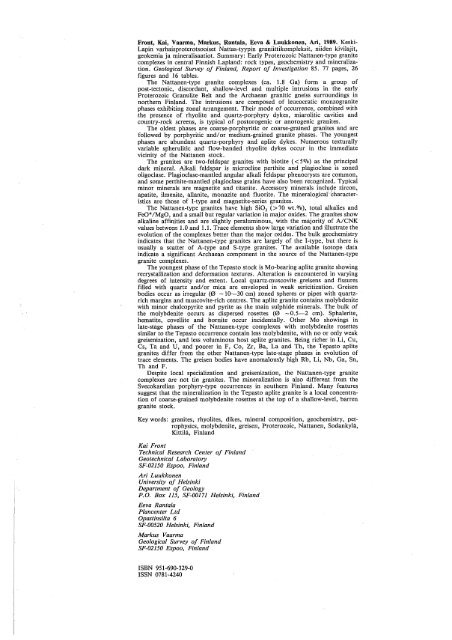nattanen-type - arkisto.gsf.fi - Geologian tutkimuskeskus
nattanen-type - arkisto.gsf.fi - Geologian tutkimuskeskus
nattanen-type - arkisto.gsf.fi - Geologian tutkimuskeskus
You also want an ePaper? Increase the reach of your titles
YUMPU automatically turns print PDFs into web optimized ePapers that Google loves.
Front, Kai, Vaarma, Markus, Rantala, Eeva & Luukkonen, Ari, 1989. Keski-<br />
Lapin varhaisproterotsooiset Nattas-tyypin graniittikompleksit, niiden kivilajit,<br />
geokemia ja mineralisaatiot. Summary: Early Proterozoic Nattanen-<strong>type</strong> granite<br />
complexes in central Finnish Lapland: rock <strong>type</strong>s, geochemistry and mineraliza-<br />
tion. Geological Survey of Finland, Report of Investigation 85. 77 pages, 26<br />
<strong>fi</strong>gures and 16 tables.<br />
The Nattanen-<strong>type</strong> granite complexes (ca. 1.8 Ga) form a group of<br />
post-tectonic, discordant, shallow-level and multiple intrusions in the early<br />
Proterozoic Granulite Belt and the Archaean granitic gneiss surroundings in<br />
northern Finland. The intrusions are composed of leucocratic monzogranite<br />
phases exhibiting zonal arrangement. Their mode of occurrence, combined with<br />
the presence of rhyolite and quartz-porphyry dykes, miarolitic cavities and<br />
country-rock screens, is typical of postorogenic or anorogenic granites.<br />
The oldest phases are coarse-porphyritic or coarse-grained granites and are<br />
followed by porphyritic and/or medium-grained granite phases. The youngest<br />
phases are abundant quartz-porphyry and aplite dykes. Numerous texturally<br />
variable spherulitic and flow-banded rhyolite dykes occur in the immediate<br />
vicinity of the Nattanen stock.<br />
The granites are two-feldspar granites with biotite (70 wt.%), total alkalies and<br />
FeO*/MgO, and a small but regular variation in major oxides. The granites show<br />
alkaline af<strong>fi</strong>nities and are slightly peraluminous, with the majority of A/CNK<br />
values between 1.0 and 1.1. Trace elements show large variation and illustrate the<br />
evolution of the complexes better than the major oxides. The bulk geochemistry<br />
indicates that the Nattanen-<strong>type</strong> granites are largely of the 1-<strong>type</strong>, but there is<br />
usually a scatter of A-<strong>type</strong> and S-<strong>type</strong> granites. The available isotope data<br />
indicate a signi<strong>fi</strong>cant Archaean component in the source of the Nattanen-<strong>type</strong><br />
granite complexes.<br />
The youngest phase of the Tepasto stock is Mo-bearing aplite granite showing<br />
recrystallization and deformation textures. Alteration is encountered in varying<br />
degrees of intensity and extent. Local quartz-muscovite greisens and <strong>fi</strong>ssures<br />
<strong>fi</strong>lled with quartz and/or mica are enveloped in weak sericitization. Greisen<br />
bodies occur as irregular (0 - 10-30 cm) zoned spheres or pipes with quartz-<br />
rich margins and muscovite-rich centres. The aplite granite contains molybdenite<br />
with minor chalcopyrite and pyrite as the main sulphide minerals. The bulk of<br />
the molybdenite occurs as dispersed rosettes (0 -0.5-2 cm). Sphalerite,<br />
hematite, covellite and bornite occur incidentally. Other Mo showings in<br />
late-stage phases of the Nattanen-<strong>type</strong> complexes with molybdenite rosettes<br />
similar to the Tepasto occurrence contain less molybdenite, with no or only weak<br />
greisenization, and less voluminous host aplite granites. Being richer in Li, Cu,<br />
Cs, Ta and U, and poorer in F, Co, Zr, Ba, La and Th, the Tepasto aplite<br />
granites differ from the other Nattanen-<strong>type</strong> late-stage phases in evolution of<br />
trace elements. The greisen bodies have anomalously high Rb, Li, Nb, Ga, Sn,<br />
Th and F.<br />
Despite local specialization and greisenization, the Nattanen-<strong>type</strong> granite<br />
complexes are not tin granites. The mineralization is also different from the<br />
Svecokarelian porphyry-<strong>type</strong> occurrences in Southern Finland. Many features<br />
suggest that the mineralization in the Tepasto aplite granite is a local concentra-<br />
tion of coarse-grained molybdenite rosettes at the top of a shallow-level, barren<br />
granite stock.<br />
Key words: granites, rhyolites, dikes, mineral composition, geochemistry, pet-<br />
rophysics, molybdenite, greisen, Proterozoic, Nattanen, Sodankylä,<br />
Kittilä, Finland<br />
Kai Front<br />
Technical Research Center of Finland<br />
Geotechnical Laboratory<br />
SF-02150 Espoo, Finland<br />
Ari Luukkonen<br />
University of Helsinki<br />
Department of Geology<br />
P. 0. Box 11.5, SF-00171 Helsinki, Finland<br />
Eeva Rantala<br />
Plancenter Ltd<br />
Opastinsilta 6<br />
SF-00520 Helsinki, Finland<br />
Markus Vaarma<br />
Geological Survey of Finland<br />
SF-02150 Espoo, Finland<br />
ISBN 95 1-690-329-0<br />
ISSN 0781-4240

















